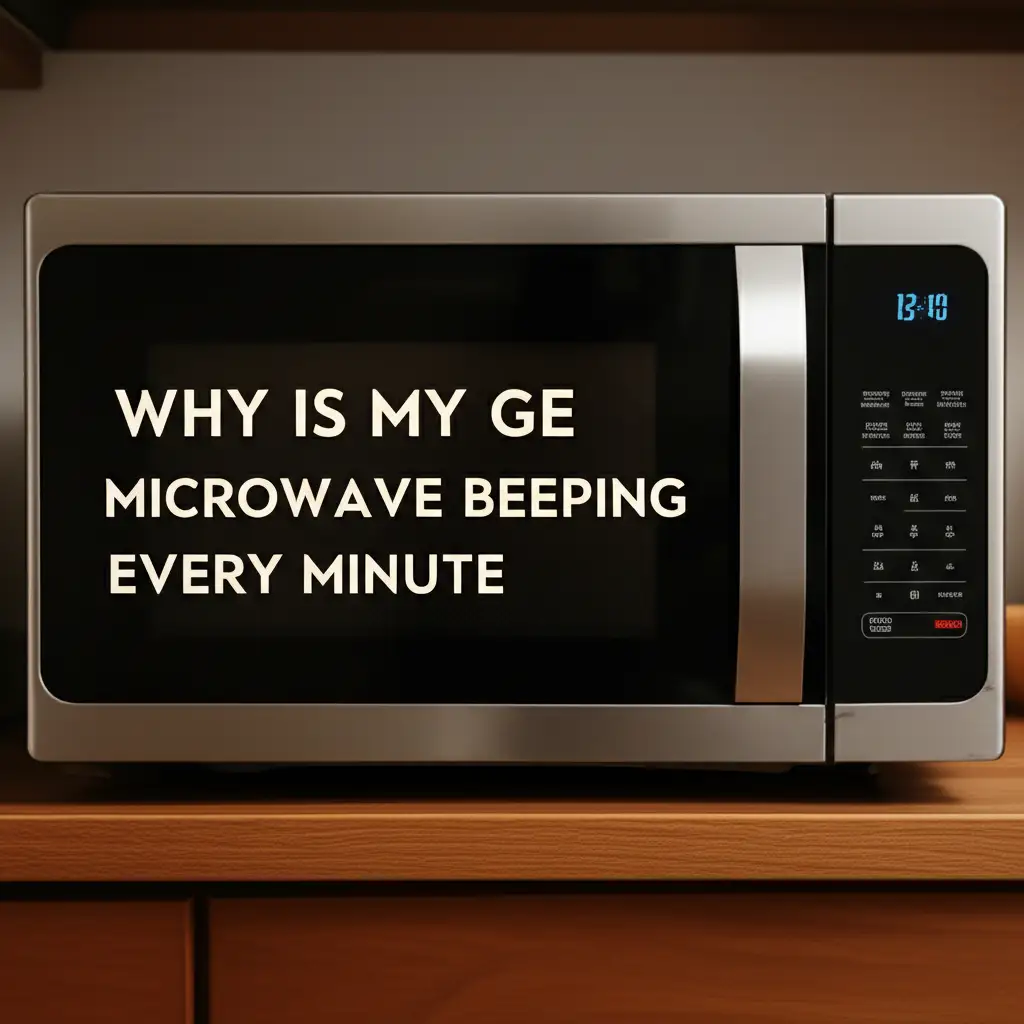· Todd Martin · Appliance Repair · 14 min read
How To Repair Panasonic Inverter Microwave Door Latch

Fix Your Panasonic Inverter Microwave Door Latch
Dealing with a faulty microwave door can stop your kitchen routine cold. A broken door latch on your Panasonic Inverter Microwave means the appliance will not start. This issue is frustrating, but it is often fixable without calling a professional. Understanding how to diagnose and repair the door latch can save you time and money. I will guide you through each step of the process.
This article provides a comprehensive guide to help you repair your Panasonic Inverter Microwave door latch. We will cover identifying common problems, essential safety steps, and a detailed repair process. You will learn to replace broken parts and test safety switches. My goal is to make this repair accessible for anyone willing to perform a DIY fix.
Takeaway
- Safety First: Always unplug the microwave and discharge the capacitor before touching internal components.
- Identify the Problem: Determine if the issue is a broken door hook, a worn latch, or a faulty safety switch.
- Gather Tools: Collect screwdrivers, needle-nose pliers, and a multimeter.
- Source Parts: Find exact replacement parts online or from an appliance parts store.
- Test Thoroughly: After repair, check all functions, especially the door latch and safety switches.
A Panasonic Inverter Microwave door latch often fails due to wear on plastic hooks or faulty internal safety switches. You can repair it by replacing broken latch components or by testing and replacing the door interlock switches. Always ensure the microwave is unplugged and the capacitor is safely discharged before starting any repair work.
Understanding Your Panasonic Microwave Door Latch System
The door latch system on your Panasonic Inverter Microwave is more than just a simple hook. It is a critical safety mechanism. This system ensures the microwave only operates when the door is fully closed and sealed. The latch assembly typically includes plastic hooks on the door and a mechanism inside the microwave frame. This mechanism contains spring-loaded levers and small electrical switches.
These switches, called interlock switches, are vital. They sense the position of the door. When the door closes, the hooks engage the latch mechanism. This action triggers the switches to allow power to flow to the microwave’s components. If any part of this system fails, the microwave will not start. It is a built-in safety feature to prevent microwave radiation leakage.
Panasonic Inverter Microwaves are known for their efficient cooking. However, their door mechanisms can wear out over time. Constant opening and closing puts stress on the plastic hooks and internal springs. Understanding these components helps in diagnosing the problem correctly. I always start by visually inspecting the door and frame.
The inverter technology in Panasonic microwaves manages power delivery smoothly. It relies on all safety features working perfectly. A faulty door latch sends a signal that the door is not secure. This signal prevents the microwave from heating or even turning on. Knowing this helps you understand why the repair is so important.
Common Symptoms of a Faulty Microwave Door Latch
Recognizing the signs of a failing door latch is the first step toward repair. Many issues can point to problems with this component. The most obvious symptom is the microwave not starting when you press the start button. It might make a humming sound but not begin heating.
Another common sign is the microwave stopping mid-cycle. This can happen if the door latch momentarily loses contact. The interlock switches briefly open, cutting power. It is a frustrating issue. You might find yourself having to Why Does My Panasonic Inverter Microwave Keep Stopping unexpectedly.
Visual cues are also important. Look at the door itself. You might see a visible gap between the door and the microwave frame. The door might feel loose or wobbly when closed. Sometimes, the door will not stay closed at all. This means the latch hooks are likely broken or severely worn.
You might also hear unusual clicking noises when opening or closing the door. This can indicate worn springs or misaligned parts within the latch assembly. If you have to push hard on the door for the microwave to start, that is a strong indicator. It means the safety switches are not engaging properly. These symptoms help narrow down the cause of the problem.
- Microwave does not start: Pressing “Start” yields no response or only a hum, but no heating.
- Microwave stops mid-cycle: The unit pauses or shuts off during operation, often requiring the door to be re-closed.
- Loose or wobbly door: The door feels unstable or does not seal tightly against the microwave frame.
- Visible gap: A noticeable space exists around the door perimeter when closed.
- Door will not stay closed: The latch cannot hold the door shut independently.
- Hard to close: You must apply excessive force for the door to latch or for the microwave to start.
- Unusual clicking sounds: Audible clicks or grinding from the latch mechanism when operating the door.
Essential Safety Precautions Before Starting Repairs
Working with any electrical appliance, especially a microwave, requires extreme caution. Microwaves contain a high-voltage capacitor. This component can store a lethal electrical charge even after the unit is unplugged. Ignoring safety precautions can lead to serious injury or even death. I cannot stress enough how important this step is.
First and foremost, always unplug the microwave from the wall outlet. Do not just turn it off; pull the plug completely. This step removes all power supply to the unit. Next, you must discharge the high-voltage capacitor. This capacitor looks like a large cylinder, often located near the transformer.
To discharge it safely, use a screwdriver with an insulated handle. Short the capacitor terminals to each other. You can also short each terminal to the microwave chassis. You might see a spark, which indicates the capacitor has discharged. Hold the screwdriver for several seconds to ensure it is fully drained. If you are unsure how to do this, watch a reliable tutorial or seek professional help. Your safety is worth it.
Wear insulated gloves for added protection. Avoid touching internal components with bare hands. Take photos as you disassemble the unit. This helps you remember where everything goes during reassembly. Keep small parts organized in separate containers. These steps ensure a safer and smoother repair process.
Diagnosing the Panasonic Microwave Door Latch Problem
Once safety precautions are in place, you can start diagnosing the specific issue. A faulty door latch can stem from several points. These include broken plastic hooks, worn-out latch springs, or defective interlock switches. Careful inspection is key to an accurate diagnosis.
Begin by visually inspecting the door hooks. These are usually two or three plastic protrusions on the microwave door. They fit into slots in the microwave’s frame. Look for any cracks, chips, or missing pieces. If a hook is broken, the door will not latch properly. This is one of the most common problems.
Next, examine the latch mechanism inside the microwave frame. Open the microwave door and look into the slots where the hooks enter. You will see levers or plungers. These should move freely. Check for any debris blocking their movement. Sometimes, food particles can jam the mechanism.
Then, focus on the interlock switches. These small switches are behind the latch mechanism. They activate when the door hooks engage. There are usually two or three of these switches. To test them, you will need a multimeter. With the microwave unplugged and the capacitor discharged, disconnect the wires from each switch. Set your multimeter to the continuity setting. Test each switch in both its open and closed positions. A working switch will show continuity in one position and none in the other. If a switch shows no continuity at all, or continuous continuity in both positions, it is faulty. You can also try to figure out why your Panasonic Inverter Microwave keeps stopping, as the interlock switches can be a culprit.
Sometimes, the door spring might be weak or broken. This spring helps the latch mechanism retract or engage. If the spring is faulty, the latch might not hold the door securely. Look for any visible signs of damage to the springs. Identifying the exact faulty component ensures you order the right replacement part.
Step-by-Step Guide: Replacing a Broken Door Hook or Latch Piece
Replacing a broken door hook or a part of the latch mechanism is a common fix. This repair often involves disassembling the microwave door or the front panel. Gather your tools before you start. You will need screwdrivers (Philips and flathead), needle-nose pliers, and the replacement part.
First, ensure the microwave is unplugged and the capacitor is discharged. Your safety is paramount. Then, you need to access the latch assembly. This typically means removing the outer casing of the microwave. Different Panasonic models have different access points. Some require removing screws from the back and sides. Others might have screws under rubber feet. Once the casing is off, you will see the internal components. For some models, you might need to understand How to Remove a Panasonic Over-The-Range Microwave to get proper access.
The door latch assembly is usually near the front of the microwave, behind the control panel or below the door opening. Carefully locate the specific broken piece. If it is a door hook, you may need to separate the inner and outer panels of the microwave door. Many microwave doors are designed to be disassembled. Look for screws around the edges of the door. Use caution as some parts may be glued or clipped.
Once you have access, remove the broken piece. This might involve unscrewing it or prying it gently from clips. Install the new door hook or latch piece. Ensure it sits securely in place. Line up any tabs or screw holes precisely. Be gentle with plastic components to avoid breaking them during installation.
Reassemble the door or the microwave’s front panel. Make sure all screws are tightened. Test the door’s operation. It should close smoothly and latch firmly. The door should feel secure, with no wobbling. If you’ve ever had to put a GE microwave door back on, this process will feel similar in terms of reassembly.
Addressing Faulty Door Latch Switches in Your Inverter Microwave
Door interlock switches are vital for microwave safety and operation. If your door hooks are fine but the microwave still does not start, a faulty switch is likely the cause. There are usually three such switches: primary, secondary, and monitor. All three must function correctly for the microwave to work.
To access these switches, you must remove the microwave’s outer casing. Remember to unplug the unit and discharge the capacitor first. The switches are typically located behind the door latch mechanism, nestled within the internal frame. They are small, push-button switches with wires connected to them. Each switch has two terminals.
Carefully note the position and wiring of each switch before disconnecting them. Taking a photo helps greatly with reassembly. Disconnect the wires from the first switch. Set your multimeter to the continuity or ohm setting. Test the switch’s continuity. A properly functioning normally open (NO) switch will show no continuity when the button is released and continuity when pressed. A normally closed (NC) switch will show continuity when released and no continuity when pressed. The primary and secondary switches are usually NO, while the monitor switch is NC.
Test all three switches. If any switch does not respond correctly, it needs replacement. Order an exact replacement part for your Panasonic model. Switches vary in their amperage ratings and physical configurations. Installing the wrong switch can create a fire hazard or simply not work.
Once you have the new switch, connect the wires in the same way they were originally. Mount the new switch securely in its bracket. Ensure it clicks properly when the door latch engages. If all switches test good and the latch mechanics are sound, you may want to look into other common microwave issues, such as how to repair an LG microwave oven not heating.
Reassembling and Testing Your Panasonic Microwave
After you have completed the repair, careful reassembly and thorough testing are crucial. This ensures the microwave is safe and fully functional. Take your time with this final stage. Rushing can lead to missed connections or improper placement of parts.
Begin by ensuring all wires are reconnected properly to the switches and other components. Check for any loose wires or connections. Make sure no wires are pinched or in the way of moving parts. Place the inner components back into their original positions. Verify that the door latch mechanism moves freely and engages the switches correctly when the door closes.
Then, reattach the microwave’s outer casing. Align the casing carefully with the frame. Screw all retaining screws back into place. Do not overtighten them, especially if they are going into plastic. Ensure the casing is secure and there are no gaps. The microwave should feel solid and stable.
Now, it is time for preliminary testing. Plug the microwave back into the wall outlet. Do not put any food inside yet. Open and close the door several times. Listen for the distinct clicks of the door latch engaging and disengaging. The door should close firmly and without excessive force.
Try to start the microwave with the door open. It should not start. This confirms the safety interlock system is working. If it starts, immediately unplug it and recheck the switch wiring. Next, close the door and attempt to start the microwave with a cup of water inside. Let it run for 30 seconds. Check if the water heats up. Also, try opening the door mid-cycle. The microwave should stop instantly. This confirms the monitor switch is operating. If you are having issues with door springs, it can be useful to look into articles on how to replace a Samsung microwave door latch spring as the mechanisms can be similar.
If everything works as expected, you have successfully repaired your Panasonic Inverter Microwave door latch. You can now use your microwave with confidence. Always prioritize safety during and after the repair.
FAQ Section
How do I know if my Panasonic microwave door latch is broken?
You will know the door latch is broken if your Panasonic microwave does not start when you close the door and press start. Other signs include the microwave stopping mid-cycle or the door feeling loose. You might also see visible damage to the plastic door hooks. A wobbly door that does not seal properly also points to a latch problem.
Can I repair a microwave door latch myself?
Yes, you can repair a microwave door latch yourself. Many common latch issues, like broken plastic hooks or faulty switches, are fixable with basic tools. However, you must follow strict safety precautions, especially discharging the high-voltage capacitor. If you are not comfortable with electrical work, seek professional help.
What causes a Panasonic microwave door latch to break?
Panasonic microwave door latches often break due to wear and tear from constant use. The plastic hooks can crack or chip over time. Internal springs can weaken, and the interlock switches can fail due to repeated activation. Sometimes, forceful closing of the door can also accelerate damage to the latch components.
Where are the safety switches located in a Panasonic Inverter Microwave?
The safety switches, also known as interlock switches, are inside the microwave. They sit behind the door latch mechanism, usually near the front frame. You will need to remove the microwave’s outer casing to access them. There are typically three switches that work together to ensure the door is securely closed before operation.
How do I discharge a high-voltage capacitor in a microwave?
To discharge a microwave’s high-voltage capacitor, first unplug the microwave. Then, use a screwdriver with an insulated handle. Carefully touch the metal shaft of the screwdriver to both terminals of the capacitor simultaneously. You might see a spark. Hold it for several seconds to ensure it is fully discharged.
What tools do I need to repair a microwave door latch?
You will typically need a set of screwdrivers, including Philips and flathead types. Needle-nose pliers can be useful for handling small parts and wires. A multimeter is essential for testing the interlock switches. You will also need replacement parts specific to your Panasonic microwave model.
Conclusion
Repairing your Panasonic Inverter Microwave door latch might seem daunting at first. However, by following this comprehensive guide, you can tackle the problem yourself. We covered identifying the signs of a faulty latch, prioritizing safety precautions, and performing the repair. From inspecting broken door hooks to testing and replacing interlock switches, you now have the knowledge.
Remember that patience and attention to detail are your best tools. Always ensure the microwave is unplugged and the capacitor is safely discharged before touching any internal parts. A functioning door latch is critical for both the operation and safety of your Panasonic Inverter Microwave. Taking the time to fix this issue restores your appliance. You can get back to enjoying your microwave without interruptions. With these steps, you can confidently bring your microwave back to full working order.





